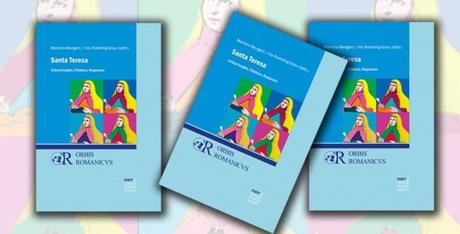
En octubre de 2015, con motivo del V Centenario, se celebró en Berlín un Congreso sobre la figura de santa Teresa, concretamente se centraba en sus escritos y los escritos sobre ella. Así lo dimos a conocer en su día en este bog. Ahora ve la luz una publicación basada en algunos de los trabajos de aquel Congreso, junto a otros que se han sumado. Ha sido publicado por Gunter Narr Verlag a cargo de Iris Roebling-Grau y Martina Bengert con el título Santa Teresa: Critical Insights, Filiations, Responses, Tübingen, Germany: Narr Franke, 2019. Los artículos están escritos mayoritariamente en inglés y alemán, aunque hay también uno en español.
Entre los aspectos tratados, se encuentran el religioso, el estético y el de la recepción de la obra teresiana a lo largo de los últimos siglos.
Contents 5 – 7
- Introduction 7 – 19
- I Santa Teresa – On Religion 19 – 69
- Teresa von Avila und Martin Luther: Annäherung an zwei Gottesfreunde (Mariano Delgado) 21 – 37
- “Como león bramando”: Jewish Motifs in Teresa of Avila’s Poetry (Gerold Necker) 37 – 53
- Die Unterscheidung der Geister in den Schriften Teresas von Avila und ihre Rezeption bei Edith Stein (Michael Plattig O. Carm.) 53 – 69
- II Santa Teresa – On Aesthetics 69 – 105
-
- Teresa de Jesús: “The Power of Words” (Juan Antonio Marcos O.C.D.) 71 – 87
- The Text As Mirror: The Book of Her Life and the Vita Christi (Iris Roebling-Grau) 87 – 105
- III Santa Teresa – Reception in the 17th-19th centuries 105 – 191
- Das Leichte ist das Schwerste: Überlegungen zur Heiligen Teresa des Gianlorenzo Bernini (Joseph Imorde) 107 – 125
- Gewinne und Verluste: Madame Guyon als kreative Leserin der Teresa von Avila (Bernhard Teuber) 125 – 149
- The Meaning of St. Teresa’s Work for Four Victorian Women (Carole Slade) 149 – 177
- Illness Narrative, Hysteria, and Sainthood: Santa Teresa as a Case Study (Jutta Weiser) 177 – 191
- IV Santa Teresa – Reception in the 20th and 21st centuries 191 – 335
- „Je ne vis plus d’être vivante, / Et ne mourrai pas d’être morte!“: Teresa von Avila in der Lyrik Anna de Noailles’ (Jenny Haase)193 – 213
- Humility and Hope in the 1914 Homage to St. Teresa of Avila (Denise Dupont) 213 – 231
- The Instrumentalization of the Myth of Santa Teresa and of the Virgen del Pilar (Martin Baxmeyer) 231 – 245
- A Question of Reference, Construction, and Composition: The City of Santa Teresa in Roberto Bolaño’s 2666 (Martina Bengert) 245 – 269
- Julia Kristeva’s New Humanism: Imagining Teresa of Avila for the Twenty-First Century (Racheal Fest) 269 – 287
- The Luminous Body as Image and Word: Reading Teresa with Marina Abramović (Devin Zuber) 287 – 303
- Die Ekstasen der Teresa von Avila: Phänomenologie, Krankheit und Resilienz (Torsten Passie und Elisabeth Petrow) 303 – 335
- V Literary Essay 335 – 349
- Letras del cielo (Alicia Dujovne Ortiz)
- VI Interview with Marina Abramović 349 – 355
- Touching Teresa: Marina Abramovic. Answers Four Questions (Interview with Devin Zuber, New York, January 19, 2019) (Marina Abramovic)
- Contributors

